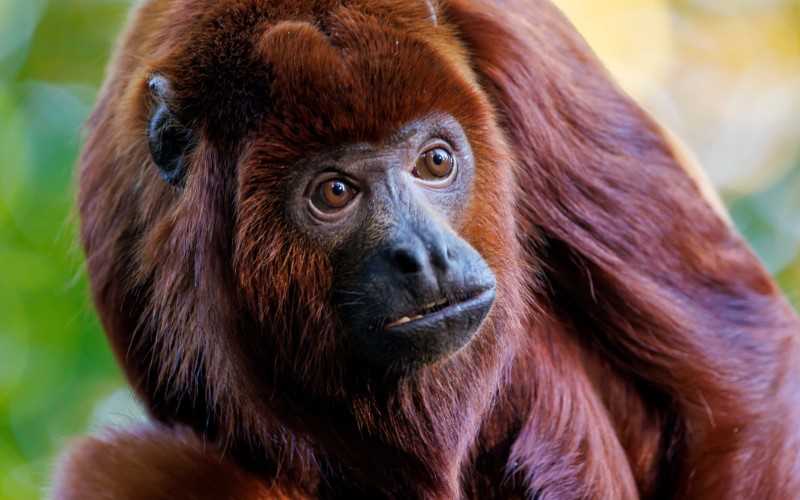
Secure your 2026 holiday today. Speak to our destination specialists about your 2027 travel dreams.
- / Destinations
- / Guyana
Overview
Introduction
An 11 night nature-packed adventure to Guyana, discovering the landscapes and wildlife of South America’s best kept secret. Guyana is an unspoilt wilderness of magnificent natural treasures, including the mighty Kaieteur Falls.
Beginning in Georgetown, the coastal capital, which features unique Dutch wood architecture and rum distilleries, while in the interior, stay at remote field stations, community-run lodges and cattle ranches.
Covered by pristine rainforest and vast savannahs, this itinerary will enable you to immerse yourself in stunning landscapes and a chance to see the country's wildlife including jaguars, giant anteaters, black caimans and a vast array of bird species, as well as rare flora.
As with all our holidays, we offer complete flexibility and the itinerary can be tailored to suit personal tastes and interests.
Board Basis: Full BoardAgenda
Day 1 - Day of arrival - Georgetown
Arrive at Cheddi Jagan International Airport and take your transfer to your accommodation, Cara Lodge, in Georgetown.
Cara Lodge was built in the 1840s. It has a long and romantic history and was the home of the first Lord Mayor of Georgetown. Over the years, the property has been visited by many dignitaries including King Edward VIll who stayed at the house in 1923. Other dignitaries have included President Jimmy Carter, HRH King Charles III and Mick Jagger. This magnificent wooden colonial home turned hotel reflects the traditions and nostalgia of a bygone era.
Overnight at Cara Lodge
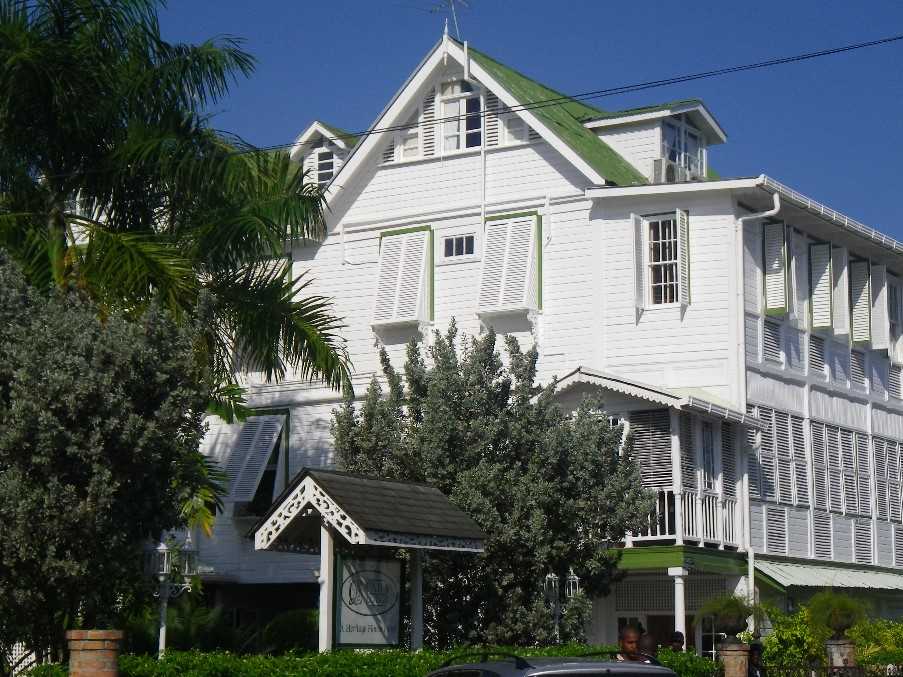 Cara Lodge, Georgetown
Cara Lodge, Georgetown
Day 2 - Explore Georgetown
This morning, we make an early start to have breakfast at one of the local stands with our host, guide and culinary master, Chef Delven Adams who will guide us around Bourda Market, the largest of the four markets in Georgetown. We will start our tour at the Guyana Shop which has all the local products produced and packaged in Guyana, before walking over to the market where we will meet some of the vendors used by the Chef. We will visit the fish market, the meat section and the haberdashery section - where one can find anything you can think of from thread to bolts of all kinds of fabric. Dry goods like rice and of course demerara sugar are abundant. A stop at the bush medicine stalls is always educational. Heading outside one can see, touch and taste a variety of local fruits and vegetables unique to this part of the world. The chef will make his purchases with your suggestions of what you would like to try and will then head home to start preparing while we continue on a tour of the city of Georgetown with an experienced guide who will give you the history, rumour and facts on Georgetown and its citizens. During your visit to Georgetown, there are a number of interesting sites that should not be missed such as the National Museum, which contains a broad selection of the animal life portrayed in taxidermy in beautiful old glass cases, and the Walter Roth Museum of Anthropology, which houses a wonderful collection of artefacts and explains the history and lifestyle of Guyana's indigenous peoples. The mix of car and walking tour, enables one to enjoy the views of other historic buildings along the promenade such as the Public Library, City Hall, the Victoria Law Courts, St. Andrews Kirk, Stabroek Market - once described as a “bizarre bazaar" - and St. George’s Cathedral, which is one of the world’s tallest, free-standing, wooden buildings. We will visit the Botanical Gardens, home to an extensive collection of tropical flora, and we will also pay a visit to a pond either in the gardens or the National Park, to feed the endangered West Indian Manatees. After our city tour, we will go to the Backyard Café for lunch. This, as the name suggests, is a backyard that Chef has turned into an exclusive little hidden gem of a restaurant. If you are interested, Chef will welcome you to join him as he prepares a wonderful meal prepared from the fruits and vegetables purchased in the morning market. Or you can just sit under the arbour and sip unique blends of juice or enjoy a cold beer, while experiencing the sounds and smells of a delicious meal in the making. Once Chef is ready, we will sample the many courses. Remember to pace yourself as you will want to try all the dishes.
In the afternoon we will take a drive through the heart of the city to the Stabroek Market area. Here we will join the afternoon commuters using the old ferry to board the river taxis which are used to cross the Demerara River. The river taxis are a faster alternative to using the Demerara Harbour Bridge. We will slowly cruise along and across the Demerara River while your guide will give a brief history of the famous buildings along the waterfront. We then continue our trip to see the Demerara Harbour Bridge, once the longest floating bridge in the world at a total length of 1,851m long. We will cross under the bridge and tie up our boat near a mangrove that is the nightly roost for a variety of birds. As the sun sets over the river we will have a cold drink and some snacks (or cutters as we call them here in Guyana) as we enjoy watching flocks of brilliant Scarlet Ibis, Snail Kites, Herons, and three kinds of Egrets as they fly across the sky and settle into the mangroves for the evening. Soon after the sun sets we return to the ferry while enjoying the city and ship lights from the river.
Overnight at Cara Lodge
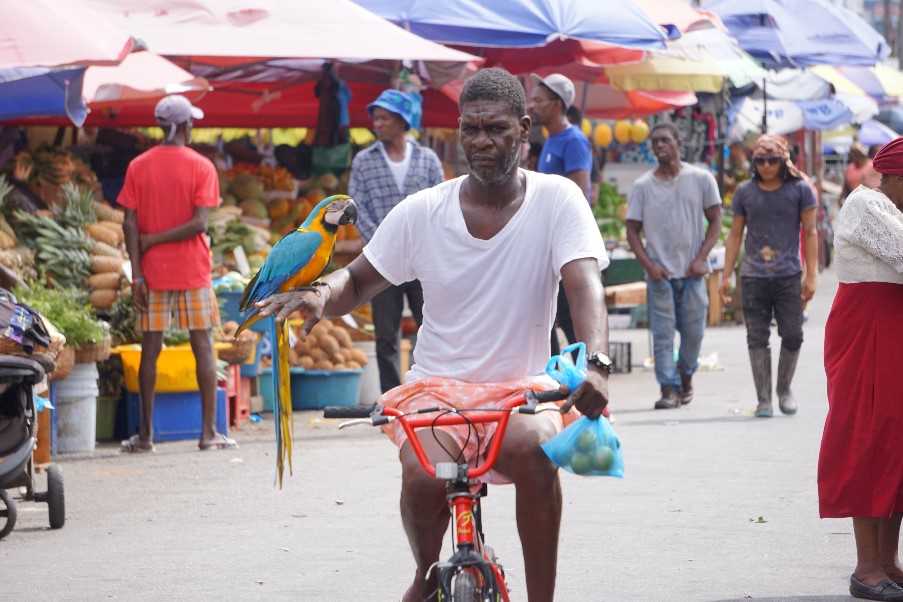 Georgetown
Georgetown
Day 3 - Kaieteur Falls
Before dawn we will travel eastward from Georgetown along the Atlantic coast to the Mahaica River. Here you will be joined by your guide before continuing to the river landing. The narrow winding road to the landing runs parallel to the river and takes us through an area that has been mainly used for the cultivation of rice and other crops. This gives us a glimpse into the everyday lives of the farming community scattered along this road. Fortunately for us, the area along the river has been well preserved and provides an excellent riverfront ecosystem inhabited by flocks of egrets, herons, ibis, various marsh tyrants, and Guyana’s national bird, the Hoatzin. On arriving at the river landing, there will be a cup of coffee or tea waiting before heading out onto the river. This is the life line of the community and is one of the main sources of transportation, food, recreation and fresh water to irrigate the fields. The river offers a rare chance to see the range-restricted Blood-coloured Woodpecker which has been badly affected by habitat loss in the ‘Guianas' coastal region. This river is one of the best places to spot Guyana's national bird, the Hoatzin (Opisthocomus Hoatzin), also known as the Stinkbird, or “Canje Pheasant". This odd bird is an unusual species of tropical bird found in swamps, riverine forest and mangrove between the Amazon and the Orinoco delta in South America. It is a pheasant-sized bird about 65 cm (25 in) long, with a long neck and small head. It is brown in colour, with paler under parts and has an unfeathered blue face with maroon eyes, and its head is topped by a spiky, rufous crest. The Hoatzin is herbivorous; it eats leaves and fruit, and has an unusual digestive system with an enlarged crop which functions as a rumen. It also produces a horrible smell to scare away potential predators. After our tour we will return to the home of our boatman where we will have breakfast before departure.
After breakfast, transfer to Eugene F. Correia International Airport to take a scheduled flight over the Demerara and Essequibo Rivers and hundreds of miles of unbroken tropical rainforest to land at Kaieteur Falls, the world’s highest free-falling waterfall. Kaieteur, which was first seen by a European on April 29, 1870, is situated in the heart of Guyana on the Potaro River, a tributary of the Essequibo. The water of Kaieteur flows over a sandstone conglomerate tableland into a deep gorge - a drop of 741 feet or 5 times the height of Niagara Falls. There are no other falls in the world with the magnitude of the sheer drop existing at Kaieteur. An Amerindian legend of the Patamona tribe has it that Kai, one of the tribe’s chiefs (after whom the falls is named), committed self-sacrifice by canoeing himself over the falls. It was believed this would encourage the Great Spirit Makonaima to save the tribe from being destroyed by the savage Caribishi. Kaieteur supports a unique micro environment with Tank Bromeliads, the largest in the world, in which the tiny Golden frog spends its entire life. The rarely seen Guiana Cock- of-the-rock nests close by. The lucky visitor may also see the famous flights of the Kaieteur Swifts or Makonaima Birds which nest under the vast shelf of rock carved over millions of years by the black water of the Potaro River. Transfer to Eugene F. Correia International Airport for your return to Georgetown.
Overnight at Cara Lodge
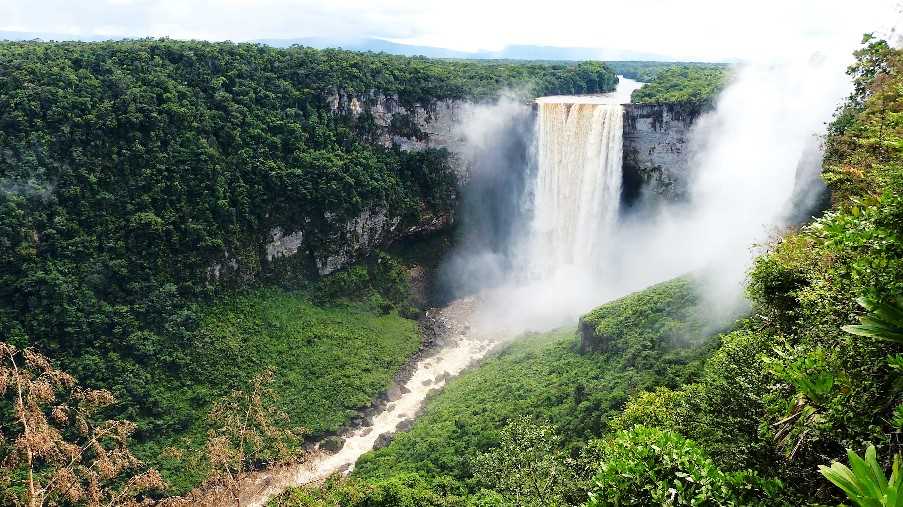 Kaieteur Falls
Kaieteur Falls
Day 4 - Lethem
Transfer to Eugene F. Correia International Airport. Where you will board a scheduled flight for your journey over the Demerara and Essequibo Rivers and hundreds of miles of tropical rainforest to land at Lethem.
There will be a tour of Lethem before continuing to Waikin Ranch, which is located in the Rupununi Savannahs of Guyana, only a half an hour’s drive from Lethem. Here you can experience life on a working ranch with activities including horseback riding, fishing, farm to table meals and bird watching. Accommodation is in four spacious cabins each with its own veranda and hammock for relaxing. Enjoy the open night sky on the lawns of the ranch or at one of the lookout points in the savannah. Experience the night breeze, the view of millions of stars and the warmth of a fire.
Overnight at Waikin Ranch
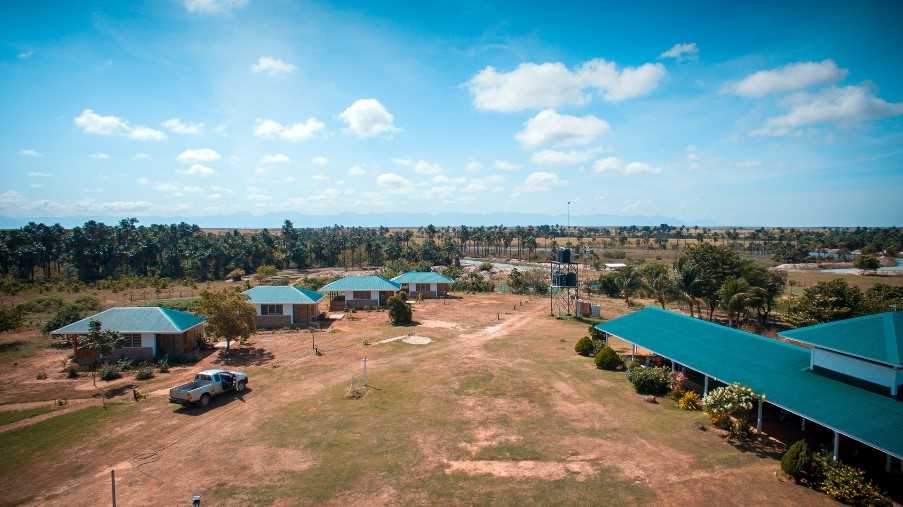 Waikin Ranch, Rupununi
Waikin Ranch, Rupununi
Day 5 - Savannah wildlife
Enjoy a guided walk through one of the trails around the ponds, and bush islands, seeking out some of the local wildlife, flora or fauna, and observing the surroundings at your own pace. Due to the natural lake and ponds, various birds now nest year round at Waikin, such as: Muscovy Ducks, Great Horned Owls, Buff Neck Ibis, Herons, Sun Parakeets, and several other species.
Ride through the Savannah along various "Bush Islands" which each harbor unique wildlife such as: ocelots, anteaters, armadillos, cappybaras, deer, various birds, and jaguars. Following lunch enjoy a trip to the lower Waterfall at Moco Moca Village. The hike is roughly 30 minutes, and a visit to the old hydro dam station is also possible.
Overnight at Waikin Ranch
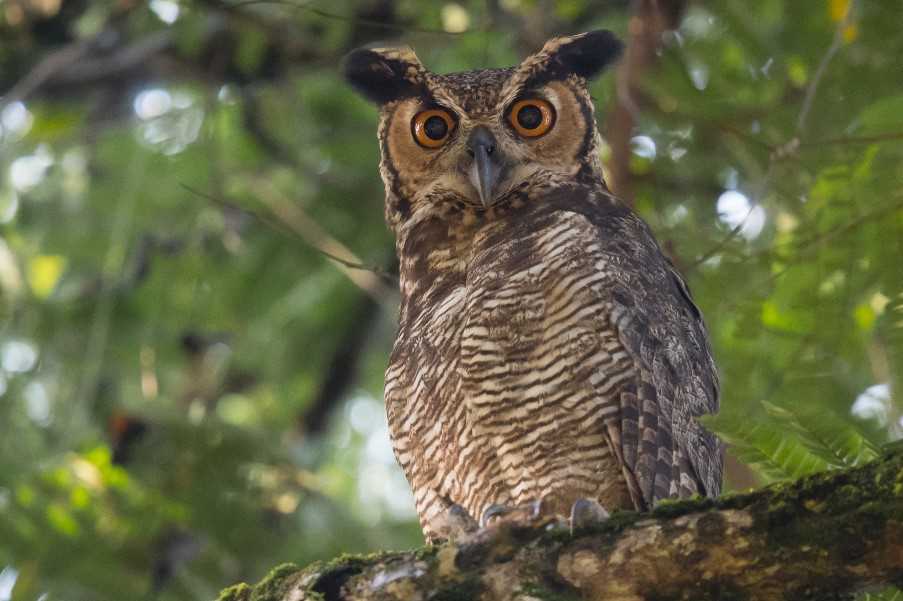 Great horned owl
Great horned owl
Day 6 - Iwokrama Canopy Walkway
Transfer from Lethem to Atta Rainforest Lodge.
The Iwokrama Canopy Walkway is situated near the southern boundary of the Iwokrama Reserve in central Guyana. The walkway has four suspension bridges leading to three platforms, the highest of which is over 30 metres above the ground. Another area where we will want to spend some time is the clearing around the lodge, as this is one of the best places to see another of Guyana’s “must see” birds, the Crimson Fruitcrow. The clearing is also a reliable site for the Black Curassow bird as there is a large and growing family party which has become habituated to people and regularly passes through the clearing. Atta Rainforest Lodge is 500 metres from the base of the Iwokrama Canopy Walkway, offering comfortable private-room accommodation with ensuite bathrooms, delicious home-cooked meals, and traditional Amerindian hospitality. The communal building houses the bar, dining area and kitchen and is open sided with views across the gardens to the towering forest, which completely surrounds the lodge. Hammocks and outdoor benches enhance the lovely gardens which include varieties of heliconias that attract over ten different hummingbirds, close enough for the perfect photo.
Overnight at Atta Rainforest Lodge
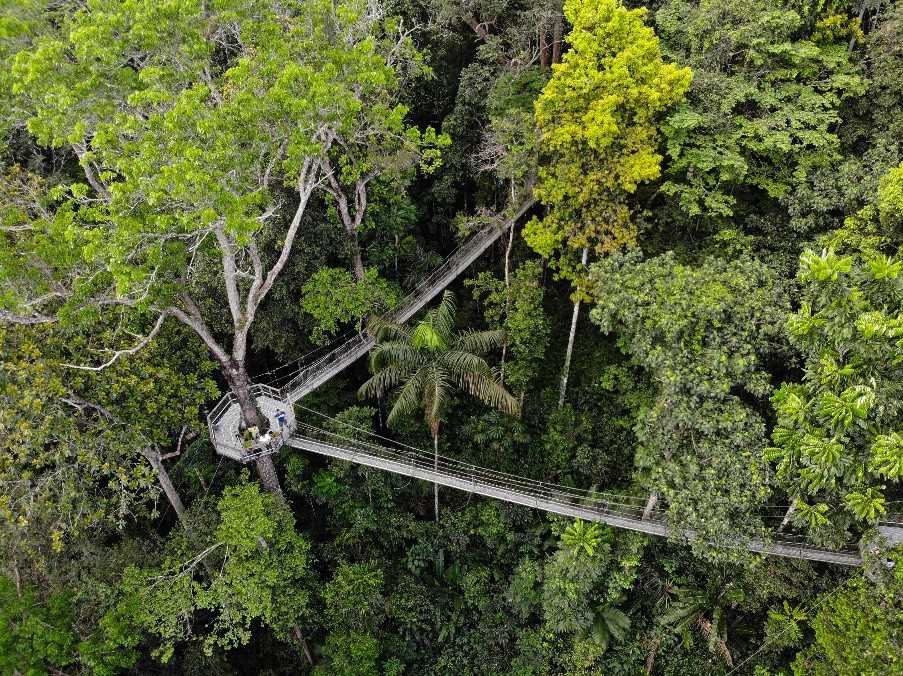 Iwokrama Canopy Walkway
Iwokrama Canopy Walkway
Day 7 - Wildlife and birdwatching
Before dawn we will return to the canopy where we can birdwatch and may see Rufous-throated Sapphire, Green Aracari, Pygmy Antwren and Guianan Streaked-Antwren. With some luck Guianan Toucanet, Pompadour Cotinga, Buff-cheeked Greenlet and a host of crown specialists may come within our view. From this tree top vantage, you can sometimes see Red Howler and Black Spider Monkeys.
Apart from the Iwokrama Canopy Walkway itself you can enjoy wildlife and birdwatching walks on the trails around the area. Many bird species, stunning insects, noisy amphibians, and playful primates make the surrounding forest their home. Deer, Tapir and agouti are also regular visitors to the lodge. Serious birders will want to search the undergrowth for the rarely seen Rufous-winged Ground-cuckoo. As darkness falls on the canopy walkway, you may see the White-winged Potoo. Night walks are also possible and something interesting or new always seems to pop on to the scene, including one of the six different cats to be found along the transnational road near the lodge.
Overnight at Atta Rainforest Lodge
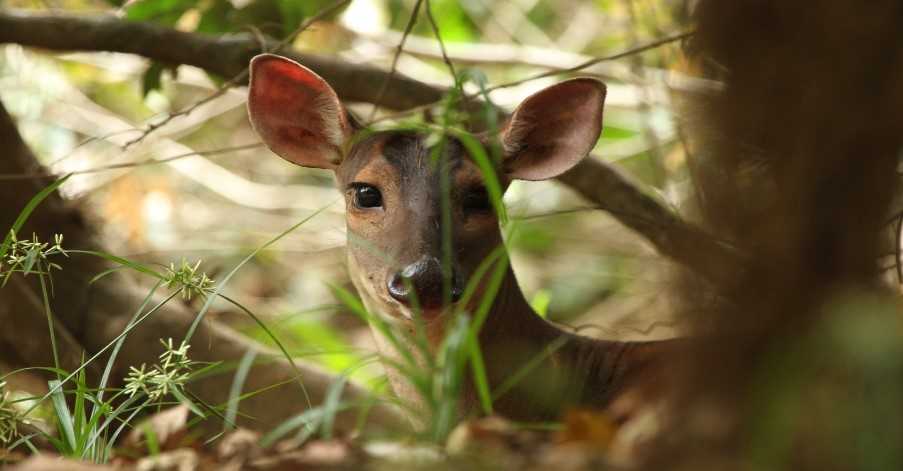 Deer
Deer
Day 8 - Iwokrama Rainforest
Welcome the dawn chorus from the canopy walkway and then return to the lodge for breakfast before departure.
Transfer along the trail that is one of the best places to see the elusive Jaguar. No promises, but many have been lucky! This road is the only north – south access in Guyana and links the country to Brazil. Even so traffic is only very occasional and wildlife is often seen along the road, such as Agouti, Tayra, Tapir and Black Curassow. The journey concludes at the Iwokrama River Lodge. The Iwokrama Rainforest is a vast wilderness of one million acres. This protected area was established in 1996 as the Iwokrama International Centre for Rainforest Conservation and Development. The Iwokrama Forest is at the heart of one of the last four untouched tropical forests of the world - The Guiana Shield of North-Eastern South America. Iwokrama was established as a living laboratory for tropical forest management. From research to business, Iwokrama ensures local economic and social benefits from forest use and conservation. The forest is in the homeland of the Makushi people, who have lived here and used the forest for thousands of years. The Iwokrama River Lodge is set overlooking the Essequibo River. Accommodation is offered in eight spacious timber cabins with en suite and verandas overlooking the river. Electricity is provided by a combination of solar and diesel generator systems, and wireless internet access is provided for free in the main building. Meals are served buffet-style in the Fred Allicock dining hall. Explore the trails around the lodge with an Iwokrama Ranger. After dark we’ll set out on the river, in hope of finding one or another of its four species of caiman, and listen for night birds such as Spectacled Owl, White-winged Potoo, Rufous Potoo, Long-tailed Potoo, Zigzag Heron or Blackish Nightjar. Using our flashlights we will look for the eyeshine of snakes including Cox boa, tree frogs and, if lucky, maybe some mammals.
Overnight at Iwokrama River Lodge
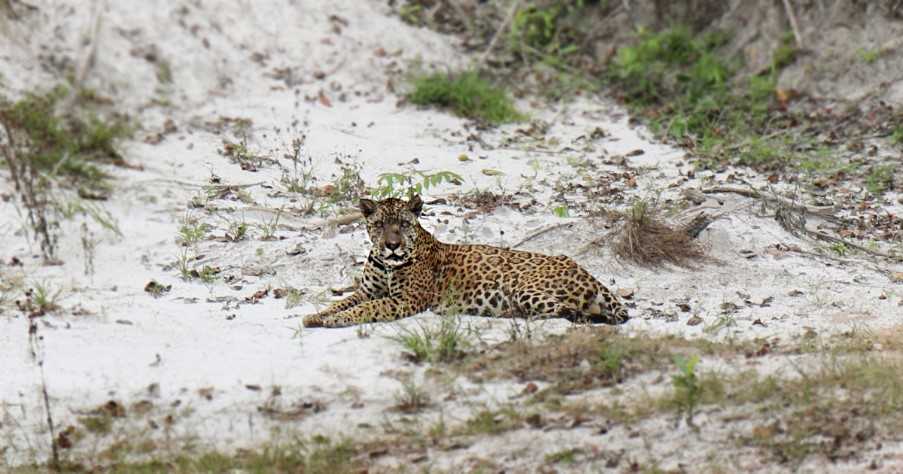 Jaguar
Jaguar
Day 9 - Turtle Mountain
Making an early start, we’ll embark on the Essequibo and circumnavigate nearby Indian House Island, before returning to the River Lodge for breakfast.
Leave the lodge by boat, birdwatching along the way, for a hike to Turtle Mountain. A well maintained trail winds through the forest before an exhilarating climb up the mountain to its summit at 935ft (approx. 360m). It takes 1 3/4hrs to walk up the mountain, but the effort is more than worth it for the breathtaking views over the forest canopy and the chance of viewing Green Aracari, White Bellbird or a fly-by of one of five types of eagles. This trail is also a great location for seeing Black Spider and Red Howler monkeys. If you think this hike may be too strenuous, you can take an alternative boat trip to Stanley Lake to search for Giant River Otters and Black Caiman. As the afternoon cools there is a boat trip to visit Kurupukari Falls to see the Amerindian petroglyphs (dependent on the water level).
Overnight at Iwokrama River Lodge
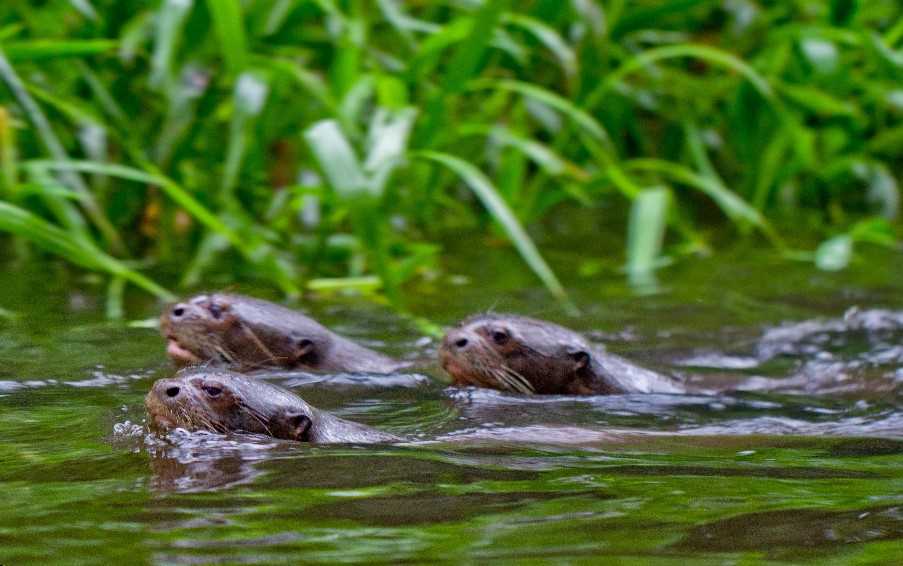 Giant River Otters
Giant River Otters
Day 10 - Wildlife of Iwokrama Rainforest
Explore the trails around the lodge with an Iwokrama Ranger.
Iwokrama is home to many bird species including the Capuchin bird, Black Nunbird, Chestnut-rumped Woodcreeper, Amazonian Antshrike, Brown-bellied Antwren, Spot-tailed Antwren, Todd’s Antwren, Spotted Puffbird, Green Aracari, Guianan Toucanet, Guianan Red Cotinga, Pompadour Cotinga, Rufous-crowned Elaenia, Bronzy Jacamar, Chestnut & Waved Woodpecker, Gray Antbird, and Strong-billed Woodcreeper. Three other Neotropical species in the Iwokrama forest of high interest are White-winged Potoo, Rufous Potoo, and Rufous-winged Ground-cuckoo. The forest is also home to many mammals and you may see Red-rumped Agouti and various species of monkey including Red Howler, Black Spider and Wedge-capped.
Overnight at Iwokrama River Lodge
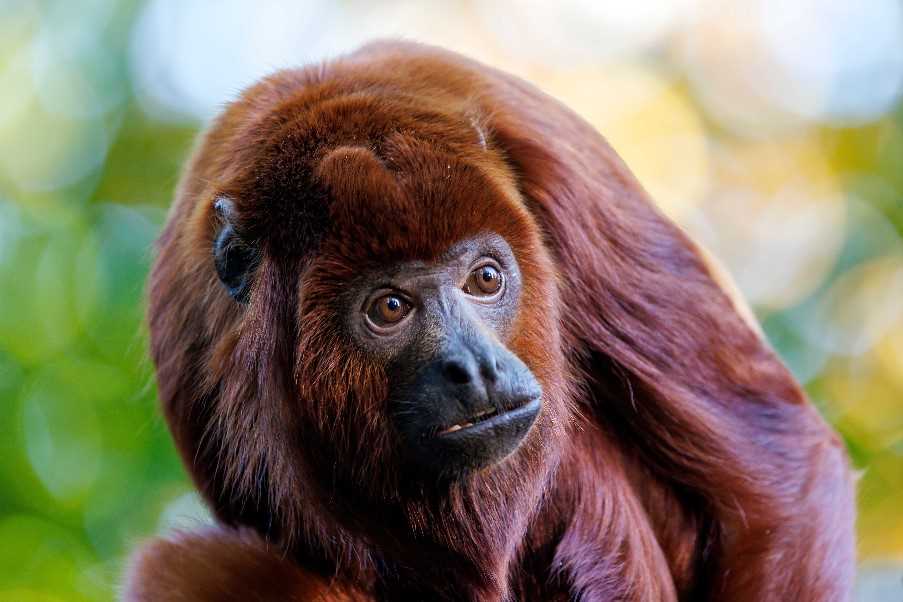 Red Howler Monkey
Red Howler Monkey
Day 11 - Georgetown
Pick up from Iwokrama River Lodge and transfer to Fair View. Depart by scheduled flight from Fair View airstrip to Mahdia (approximately 3hrs ground time) and then reboard flight for return journey over hundreds of miles of tropical rainforest to land at Eugene F. Correia International Airport. Transfer to Georgetown.
Pick up at your hotel and transfer to a local restaurant. Guyana has a plethora of incredible foods. From grass-fed cows, delicious fresh fish, succulent prawns, wonderful tasting chicken and the colourful fresh fruits and vegetables. Now combine all that with a trained international Guyanese chef bringing together a contemporary form of classical Guyanese cuisine and served in the delightful garden setting of his home. A garden that combines the smells of the herbs with the sight of fruits hanging from the trees around you. Lit by stars, moon and candlelight this is an unforgettable feast. Eon John will be cooking right in front of you so it’s a very personal experience. He starts with a delicious rum cocktail (or mocktail). The menu is designed to suit your palette, so if you fancy the bush fish like hassar lovingly crafted into a delicious meal or maybe the golden Gilbaca catfish which is one of the sweetest tasting fish ever. The ingredients have been personally sourced to give you a highlight of your dining experience in Guyana. Chef Eon John, the Singing Chef, will serenade you under the stars as you finish your meal.
Overnight at Cara Lodge
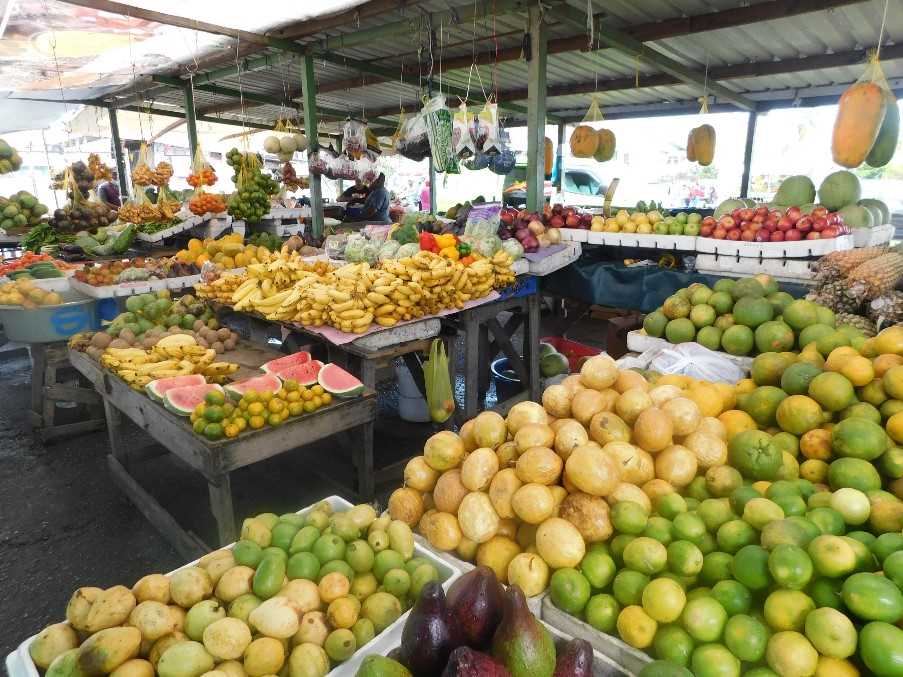 Georgetown market
Georgetown market
Day 12 - Day of departure
Before your evening departure, you will have an excursion to birdwatch in Georgetown's Botanical Gardens - 3 Hours Duration. Choose from 0545hrs or 1500hrs for a pickup and transfer to the extensive and beautiful Georgetown Botanical Gardens where, if we are lucky, we will have views of the Blood-coloured Woodpecker. This colourful Veniliornis is found only in the Guianas and even here almost wholly limited to the narrow coastal plain. The gardens host Snail Kite, Gray Hawk, Pearl Kite, Carib Grackle, Red-bellied and Red-shouldered Macaws and the rare festive parrots. On trails in the back of the gardens you may see Yellow-chinned Spinetail, Black-crested Antshrike, Silver-beaked Tanager, Buff-breasted Wren, Golden-spangled Piculet and Ashy-headed Greenlet. You may even want to take a break from birding to feed some manatees in one of the nearby ponds, before returning to your hotel.
Pickup and transfer to Cheddi Jagan International Airport for your departing flight back to the UK.
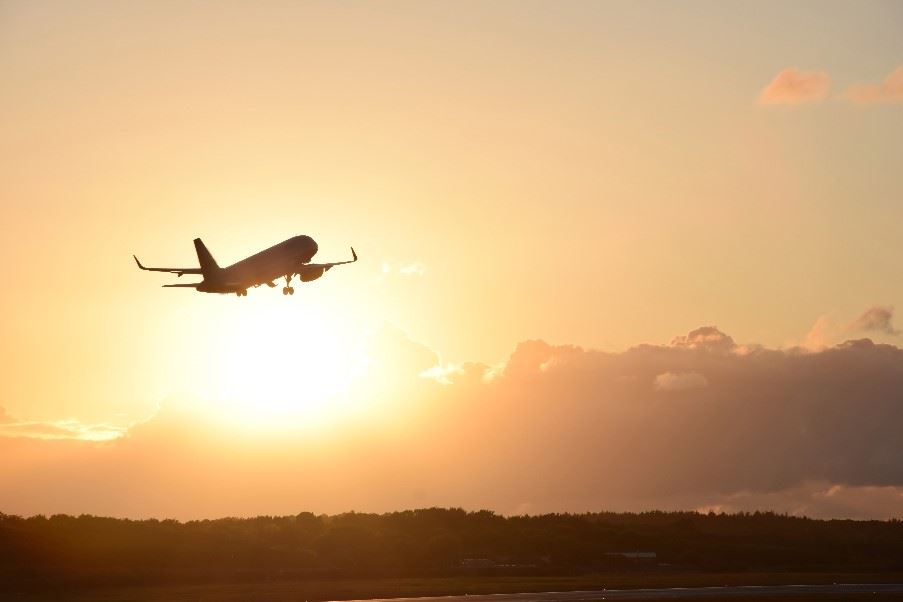
Accommodation
Cara Lodge - Night 1 to 3
Cara Lodge is a heritage house hotel built in the 1840s featuring unique Guyanese wooden colonial architecture. The hotel originally consisted of two houses and has a long and romantic history. It was the home of the first Lord Mayor of Georgetown.
Cara Lodge is a heritage house hotel built in the 1840s featuring unique Guyanese wooden colonial architecture. The hotel originally consisted of two houses and has a long and romantic history. It was the home of the first Lord Mayor of Georgetown. Over the years it has been visited by many dignitaries including King Edward VIll who stayed at the house in 1923. Other luminaries have included President Jimmy Carter, HRH King Charles III, Channing Tatum and Mick Jagger.
This comfortable, centrally-located hotel suggests the nostalgia of a bygone era, but also offers modern facilities and friendly service in a congenial atmosphere. The Mango Patio is a favourite meeting point for evening drinks and the Bottle Restaurant is considered one of Georgetown’s best.
Waikin Ranch - Night 4 to 5
Waikin Ranch sits on the gently undulating tropical wetlands of the North Rupununi, close to the town of Lethem and the border of Brazil. The vast grasslands surrounding the ranch are crisscrossed by creeks flanked by palms and, in the distance, the Kanuku Mountains rise from the savannah.
Waikin Ranch sits on the gently undulating tropical wetlands of the North Rupununi, close to the town of Lethem and the border of Brazil. The vast grasslands surrounding the ranch are crisscrossed by creeks flanked by palms and in the distance, the Kanuku Mountains rise from the savannah.
Waikin is a small working ranch, farming cattle, pigs, chickens, ducks and fish plus an orchard and vegetable gardens. You can join the kitchen team in the gardens to select your own fruit and vegetables for the wonderful farm-to-table cuisine experience or fish in the ponds for your dinner.
Four spacious cabins overlook the gardens and feature glass doors that fold back to open onto a wrap-around veranda, perfect for relaxing in your hammock. The bathrooms feature open-to-the-sky shower and solar-power allows a fan-cooled bedroom.
Atta Rainforest Lodge - Night 6 to 7
Deep within the Iwokrama Rainforest lies a remarkable rainforest lodge and tree-top canopy walkway. Atta Rainforest Lodge inhabits an opening in the forest and offers a complete immersion in the rainforest experience. Lovely gardens attract over 12 species of hummingbirds and lawns lead to the forest verge, where Black Curassow, deer, monkeys, Red-rumped Agouti and sometimes tapir come to feed.
Deep within the Iwokrama Rainforest lies a remarkable rainforest lodge and tree-top canopy walkway. Atta Rainforest Lodge inhabits an opening in the forest and offers a complete immersion in the rainforest experience. Lovely gardens attract over 12 species of hummingbirds and lawns lead to the forest verge, where Black Curassow, deer, monkeys, Red-rumped Agouti and sometimes tapir come to feed.
Simple but comfortable rooms feature ensuite bathrooms with open-to-the-sky showers, so the birdwatching extends into your rooms. The open-sided dining room overlooks the gardens and, weather permitting, dinner is served under the stars, to the sounds of the rainforest at night. Atta is well known for its indigenous influenced home-cooked meals and its warm, friendly hospitality.
An easy 15-minute walk along a forest trail leads to the Iwokrama Canopy Walkway, a series of suspension bridges and decks up to 30 metres in height and 154 metres in length. This allows close up views of the mid and upper canopy of the forest and allows wildlife to be relatively free from human intrusion. This is an excellent platform for birdwatching or simply enjoying the unique opportunity to be in the tree-tops.
The forest around the walkway contains some well-maintained trails allowing access to various habitats with opportunities to spot a Jaguar. The birding, in particular, is extremely rich and includes several Guiana Shield endemics.
Iwokrama River Lodge - Night 8 to 10
Nestled on the banks of the majestic Essequibo River is the Iwokrama River Lodge and Research Centre. The Iwokrama rainforest is located in the geographical heart of Guyana: it comprises one million acres (371,000 hectares) of forest or 1.6% of Guyana’s landmass and 2% of Guyana’s forests. It is part of the Iwokrama International Centre for Rain Forest Conservation and Development, an autonomous non-profit institution established by Guyana and the Commonwealth, founded to promote the conservation and the sustainable and equitable use of tropical rainforests.
Nestled on the banks of the majestic Essequibo River is the Iwokrama River Lodge and Research Centre. The Iwokrama rainforest is located in the geographical heart of Guyana: it comprises one million acres (371,000 hectares) of forest or 1.6% of Guyana’s landmass and 2% of Guyana’s forests. It is part of the Iwokrama International Centre for Rain Forest Conservation and Development, an autonomous non-profit institution established by Guyana and the Commonwealth, founded to promote the conservation and the sustainable and equitable use of tropical rainforests. It aims to show how tropical forests can be conserved and sustainably used for ecological, social and economic benefits to local, national and international communities.
Iwokrama River Lodge has eight, perfectly situated, river-facing cabins, each of which is spacious and beautifully designed and equipped with fans, bathroom, electricity supplied by solar power, and verandas with hammocks. From these comfortable cabins, watch the sun go down whilst listening to the many local birds and other wildlife or simply relax in your hammock.
It is a short stroll from the cabins to the Fred Allicock building which houses the dining area, shop, two science laboratories and a conference room plus researchers and administrators’ offices. In the large open-sided dining room, guests, Iwokrama staff and visiting researchers have an opportunity to mingle.
Nature trails start around the grounds, leading into the rainforest for excellent birding and wildlife opportunities. Or, take a boat trip to explore the river, including a night trip to spotlight for wildlife or to visit the nearby petroglyphs. Iwokrama’s most popular excursion is to Turtle Mountain, an exciting hike up a jungle trail to the top of the mountain for fantastic views across the top of the canopy.
Evening or dawn drives are available to search for wildlife, especially the elusive jaguar. Iwokrama has a healthy population of this apex predator but you will still require some luck to see one.
Cara Lodge - Night 11 to 11
Cara Lodge is a heritage house hotel built in the 1840s featuring unique Guyanese wooden colonial architecture. The hotel originally consisted of two houses and has a long and romantic history. It was the home of the first Lord Mayor of Georgetown.
Cara Lodge is a heritage house hotel built in the 1840s featuring unique Guyanese wooden colonial architecture. The hotel originally consisted of two houses and has a long and romantic history. It was the home of the first Lord Mayor of Georgetown. Over the years it has been visited by many dignitaries including King Edward VIll who stayed at the house in 1923. Other luminaries have included President Jimmy Carter, HRH King Charles III, Channing Tatum and Mick Jagger.
This comfortable, centrally-located hotel suggests the nostalgia of a bygone era, but also offers modern facilities and friendly service in a congenial atmosphere. The Mango Patio is a favourite meeting point for evening drinks and the Bottle Restaurant is considered one of Georgetown’s best.
Route Map
Useful information
Best time to go
- JAN
- FEB
- MAR
- APR
- MAY
- JUN
- JUL
- AUG
- SEP
- OCT
- NOV
- DEC
Time Difference
GMT - 5 hours
Currency
Guyanese Dollar
Language
English
Average flight times
9 hours 46 minutes
-
Average temperature
Average rainfall
- JAN
- FEB
- MAR
- APR
- MAY
- JUN
- JUL
- AUG
- SEP
- OCT
- NOV
- DEC
Make an Enquiry
Please use this form to request further information about a Sunvil holiday or destination.
We promise that a member of our specialist reservation teams will reply personally to your holiday enquiry before 5.30pm if received before 12.00pm (Monday to Friday). Enquiries received after 12.00pm will be replied to within 24-hours (excluding Sundays).
If your enquiry is of an urgent nature, please telephone our dedicated reservation teams on the numbers listed below.
Our lines are open from 9.00am to 5.30pm Monday-Friday and from 9.30am to 4.30pm Saturday.
- Greece: 020 8758 4758
- Cyprus: 020 8758 4759
- Portugal, the Azores, Spain, Italy, Sicily and Scandinavia: 020 8758 4722
- Latin America: 020 8758 4774
- Marketing: 020 8758 4731
Required Information
* Mandatory InformationWe promise that a member of our specialist reservation teams will reply personally to your holiday enquiry before 5.30pm if received before 12.00pm (Monday to Friday). Enquiries received after 12.00pm will be replied to within 24-hours (excluding Sundays).
If your enquiry is of an urgent nature, please telephone our dedicated reservation teams on the numbers listed below.
Our lines are open from 9.00am to 5.30pm Monday-Friday and from 9.30am to 4.30pm Saturday.
- Greece: 020 8758 4758
- Cyprus: 020 8758 4759
- Portugal, the Azores, Spain, Italy, Sicily and Scandinavia: 020 8758 4722
- Latin America: 020 8758 4774
- Marketing: 020 8758 4731
Required Information
* Mandatory InformationThank you for your enquiry
Thank you for your enquiry. A member of our specialist reservation teams will be in touch shortly.
If your enquiry is of an urgent nature, please telephone our dedicated reservation teams on the numbers listed below.
Our lines are open from 9.00am to 5.30pm Monday-Friday and from 9.30am to 4.30pm Saturday.
- Greece: 020 8758 4758
- Cyprus: 020 8758 4759
- Portugal, the Azores, Italy, Sicily and Scandinavia: 020 8758 4722
- Latin America: 020 8758 4774
Your details have been saved
Feel free to continue to browse the site and add to your enquiry. Don't forget to send the enquiry before you leave!
My Suitcase
We understand that so much choice can be overwhelming which is why we have developed 'My Suitcase'. This facility allows you to save and compare your favourite holidays, and even allows you to return to your selection at a later stage.
Why not use 'My Suitcase' to compile a wish list of your future Sunvil holidays?
